
This application note demonstrates the performance for the measurement of sulfur in ultra-low sulfur diesel using full polarization in 90° Cartesian geometry EDXRF.

This application note demonstrates the performance for the measurement of sulfur in ultra-low sulfur diesel using full polarization in 90° Cartesian geometry EDXRF.

This application note demonstrates the measurement of the major binary alloy elements nickel and iron, and the critical tramp elements phosphorus, sulfur, and arsenic.

This app note demonstrates the measurement of chlorine, lead, and metals using the Rigaku NEX QC+ QuantEZ for the general screening of refuse-derived fuel (RDF).

The analysis of gemstones is demonstrated, using low-power 50W EDXRF with indirect excitation.

Material identification, also called positive material identification (PMI), is used to analyze and identify materials for quality assurance and quality control to verify proper alloy or material is being used.

This application note demonstrates the analysis of thin films, by X-ray fluorescence (XRF) with the fundamental parameters (FP) method.

Analysis of air filters demonstrated by EDXRF indirect excitation with secondary targets and polarization in full Cartesian geometry.

Polluted soil negatively impacts the ecosystem. This application note demonstrates that a unique matrix correction that improves calibration accuracy for XRF analysis of heavy elements, including hazardous ones, in soil and sediment.

The analysis of organic chloride in crude is demonstrated per ASTM D4929 Part C using Monochromatic EDXRF (MEDXRF).
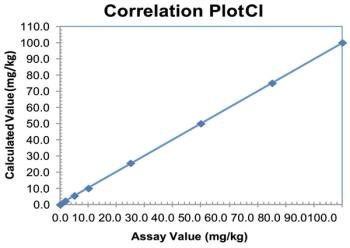

This application note demonstrates the analysis of copper and iron on Millipore and cation water filters by energy dispersive X-ray fluorescence, and highlights the performance of the Rigaku NEX DE Energy Dispersive X-ray Fluorescence Spectrometer.
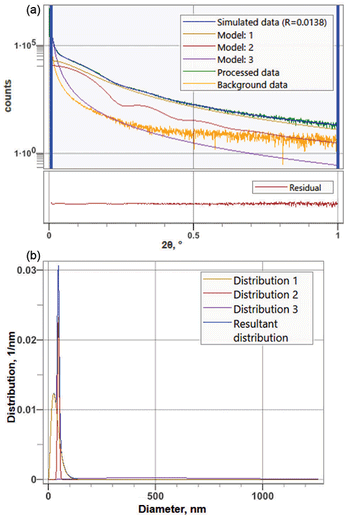
For miniaturization of devices, nanoscale BT research has been actively conducted, along with research on the enhanced dielectric properties of nano-capacitor materials.

Limestone is widely used as the main ingredient in cement and mortar, and as an aggregate in concrete and asphalt for building roads. It iis also used as a soil conditioner and is the raw material for making quick lime and slaked lime. During mining and processing operations, limestone composition must be monitored and controlled to ensure proper quality and characteristics are achieved for a variety of products. This application note demonstrates the measurement of carbonates and major oxides in high calcium limestone by EDXRF using empirical calibration.

Cement is one of the most important materials for construction. ASTM C114-11 covers chemical analysis of hydraulic cement. XRF spectrometry is used for chemical composition analysis of cement due to its simple sample preparation and high precision. This application note demonstrates quantitative analysis for Portland cement by the pressed powder method according to ASTM C114-11 on the Rigaku Supermini200, a benchtop sequential wavelength dispersive XRF spectrometer.

The measurement of zirconium (Zr) conversion coating on aluminum is demonstrated.


Terephthalic acid (TPA) and purified terephthalic acid (PTA) are precursors in the making of polyester PET for polyester films, bottle resin, textile fabrics, and specialty chemicals. During production and use of TPA and PTA, the catalysts Co, Br and Mn must be closely monitored to ensure optimum product quality. Rigaku EDXRF Application Note #1539 describes the analysis of concentrations of Co, Br and Mn in TPA and PTA solutions and highlights the performance of the Rigaku NEX OL on-line EDXRF process analyzer.
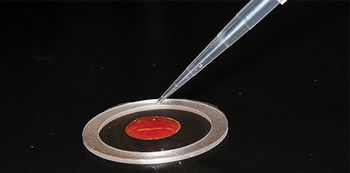
The Rigaku NEX CG combines secondary and polarization target excitation, with a high performance SDD detector, to deliver optimal EDXRF sensitivity. In conjunction with UltraCarry, the NEX CG is an ideal tool for the trace elemental analysis of aqueous solutions down to parts-per-billion levels. This technique is suitable for many applications, including: 1) monitor effluents, waste streams, and discharge waters; 2) screen for common metals; 3) measure hazardous elements; 4) QC of production rinse waters; 5) pavement run-off; 6) storm water run-off; 7) agricultural run-off; 8) site remediation; and 9) soil leachates.
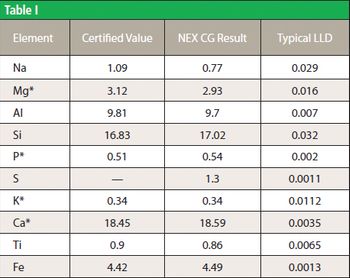
The Rigaku RPF-SQX software automatically deconvolutes spectral peaks and models the sample matrix and X-ray absorption/enhancement effects using fundamental XRF equations. The RPF-SQX software is simple to use and offers many ways to craft a matrix model based on the specific fly ash composition, allowing semi-quantitative analysis without the use of reference standards.

Paper and plastic are coated with a thin layer of silicone during the manufacture of labels, tape or other adhesives, or as a barrier coating against air in the packaging of food, medical products and other materials. EDXRF analysis with the Rigaku NEX QC is shown to be an excellent tool for measuring silicone coating to ensure the proper physical properties of the product are maintained.
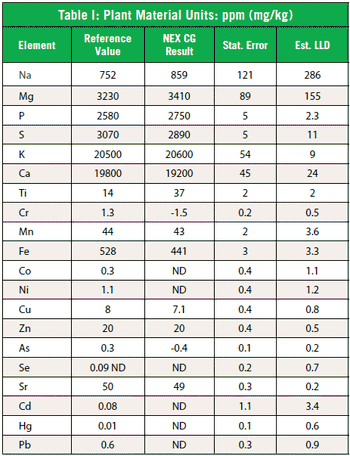
In the agri-food sector it is important to not only study the soil composition and use of fertilizers, but also the uptake of nutrients and potentially toxic elements within the plants and crops themselves.

Activated charcoal is used as a filter medium. As activated charcoal is processed, sulfur and chlorine levels are monitored EDXRF offers a fast and simple low cost method of measurement.

Rigaku EDXRF application note #1495 demonstrates the analysis of lead-zinc ore using the empirical calibration method. Elemental analysis is important in the examination of ores, from screening throughout the processing areas to final determination. The described method yields excellent results for screening and characterization of lead/zinc ore at the mine site or processing facilities for optimum product QA/QC.

This application note demonstrates that single calibration for diverse materials, such as minerals, ores and refractories, was established by the fusion method on the Rigaku Supermini200, a benchtop WDXRF spectrometer.

In the agri-food sector it is important to not only study the soil composition and use of fertilizers, but also the uptake of nutrients and potentially toxic elements within the plants and crops themselves. Rigaku Application Note 1350 describes the analysis of agricultural soils and plant materials by EDXRF.

The analysis of glass and raw materials is demonstrated in the manufacturing of soda-lime glass, which makes up 90% of the global glass production and is used to make windows, glassware and bottles. The Rigaku NEX CG spectrometer yields excellent performance for the elemental analysis of raw materials and final characterization of finished glass.
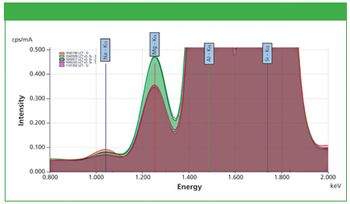
The analysis of coal is demonstrated, with specific emphasis on the measurement of Na2O, using a Cartesian geometry energy dispersive X-ray fluorescence (EDXRF) spectrometer employing the Fundamental Parameters (FP) approach.

Published: February 1st 2021 | Updated:

Published: September 1st 2020 | Updated:

Published: September 1st 2019 | Updated:

Published: February 1st 2013 | Updated:

Published: March 17th 2015 | Updated:

Published: May 14th 2015 | Updated: